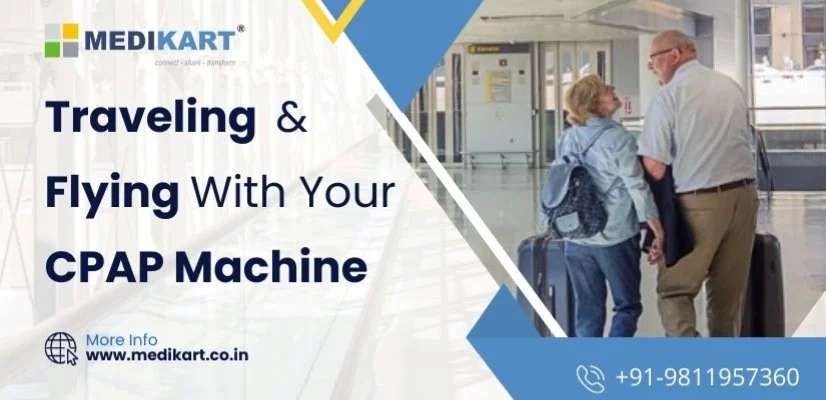Top 10 Tips and Checklists
When you rely on a CPAP machine to get a decent night’s sleep, the prospect of traveling can be intimidating. Using this article’s checklist and advice eases CPAP machine travel, promotes compliance, and guarantees a good night’s sleep. Enjoy the benefits of CPAP therapy on the go with some extra effort and preparation. Whether flying, taking an RV trip, or camping, you can still use it.
10 Tips for Traveling with CPAP
- Test and Inspect Your Equipment Two Weeks Before Your Trip — Assess your CPAP machine, mask, tubing, and accessories for wear or issues before your trip. Do this at least two weeks in advance to have time for necessary replacements or backups. Test new travel accessories, like a CPAP battery, at home.
- Replace Any Worn CPAP Supplies — Before your travel, it’s a good idea to replace any worn CPAP supplies with new materials. Maintaining a clean tube, cushion, and air filter is easier and reduces the risk of damage.
- Clean and Dry Your Equipment Before Packing – You’ll want to clean and dry your equipment right away before packing it. To prevent mold and mildew from growing in your mask, tubing, or humidifier, make sure it’s completely dry.
- Extra CPAP Supplies – Reserve space in your suitcase for spare supplies, including backup mask cushions, machine filters, and extra headgear. These extras can help you maintain your therapy in unexpected situations like breakage, pet damage, law changes, or loss.
- Always carry a copy of your CPAP prescription – Having your prescription on hand is essential in case of unfavorable conditions, even though you may never need it. You’ll likely need it to obtain new components or supplies during your trip, although you may not be asked to show it. NTS or supplies during your trip.
- Water Should Be Brought From Home – To prevent mineral buildup or calcification in your CPAP machine, use only distilled water. We don’t recommend tap water, and depending on your travel destination, it may not be practical or healthy.” To ensure your peace of mind, bring your own distilled CPAP water.
- Bring Easy Cleaning Methods — Sometimes soaking your supplies in hot soapy water isn’t possible. In such cases, CPAP wipes are a fantastic option for regular cleaning.
- Bring a Backup Power Source —A CPAP backup battery isn’t essential, but having one ensures continuous therapy during uncertain energy stability while traveling off the grid.
- Extend Your Options with DC Converters and Extension Cords – Using a DC converter expands your therapeutic options. This device enables you to power your equipment with 12V DC outlets, solar panels, or CPAP backup batteries like the EXP48 and EXP96 Pro. Bringing an extension cord ensures you won’t face constraints due to tubing and power cord length or lack of access to a nearby outlet.
- Get a Medical Alert Wallet Card -A medical alert wallet card could save your life, even if you’re not traveling or alone, by providing first responders with your health history and enabling proper treatment if you become unresponsive. Having a medical alert wallet card is essential.
8 Tips for Flying with CPAP
- Check your Luggage, Not Your CPAP — Your CPAP machine cannot be carried on as it is a medical device. Since the machine is sensitive, you should keep it with you at all times.
- Invest in a Carrying Bag — To make travel easier, most new CPAP machines come with a machine-specific carrying case. If you didn’t carry your CPAP machine in a separate bag, we recommend doing so since the airline won’t consider it a carry-on. Even if you use an old duffle bag, you will appreciate the extra space in your authorized carry-on
- Bring Distilled Water If You Need To – TSA allows CPAP users to bring 3.4 oz of distilled water in their carry-on luggage for flights. For checked bags, there’s no formal limit, but the TSA recommends reasonable quantities of liquids.
- Copying important documents can be quite useful – Airline staff and TSA agents can detect medical gadgets. Showing documentation of FAA approval can clear doubts. Even though modern CPAP machines are usually FAA-approved for flights, having the documentation is wise.
- Get to Know Your Aircraft Layout – Use TripAdvisor’s Seat Guru feature to look up your flight’s floor plan in advance. You can use this feature to get a powered outlet for your equipment or find seats with more legroom.
- Do you want to travel internationally? Bring an Outlet Adapter — New CPAP machines automatically detect and adjust to higher-voltage outlets, but you’ll need a country-specific converter and a power source that’s qualified for at least 220v.
- Make a 48-hour advance reservation with your airline — Familiarize yourself with your airline’s in-flight CPAP usage restrictions. Some airlines require a CPAP battery with a higher capacity than your flight’s duration, even though domestic aircraft cannot reject your machine. Contact the airline 48 hours ahead of time to ensure a smooth flight. Here are some typical regulations that we have listed below.
- Don’t Forget About Waterless Humidification – Portable CPAP machines like ResMed AirMini and HDM Z2 have waterless humidification options. These options can help you save space and travel lighter if you can’t bring distilled water.
Disclaimer
The information provided is for general knowledge only. Consult your doctor for personalized advice and treatment. Medikart HealthCare not liable for any actions taken based on this info.

